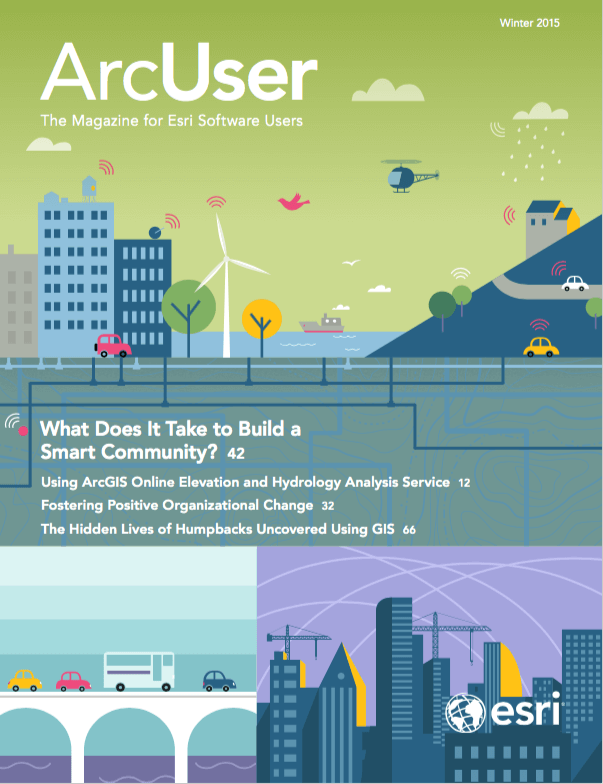Evangelist shares his best practices for introducing GIS
When Johnson Kosgei was a teenager growing up in Kenya in the 1990s, a postal services company donated to his high school a decommissioned IBM mainframe. This cast-off piece of hardware was Kosgei’s first exposure to a computer, and the machine’s potential fascinated him, awakening an obsession with using technology to better understand the world.

He was one of the first graduates of the geomatic engineering program at Kenya’s Jomo Kenyatta University of Agriculture and Technology. There he focused on remote sensing and benefited from the university’s Esri-funded remote-sensing lab. Kosgei began his career as a GIS consultant for the World Agroforestry Centre. He later joined the Green Belt Movement (GBM), a Nairobi-based conservation and economic-development organization, as part of the organization’s graduate volunteer program. GBM had developed a GIS strategy and was implementing it.
When he arrived at GBM, Kosgei’s work as a volunteer included mapping of potential GBM project areas and producing maps to support GBM efforts. Kosgei was promoted from a volunteer position to the position of assistant project officer. He was eventually promoted to the position of GIS analyst to support GBM’s GIS specialist in line with the organization’s GIS strategy. As a GIS analyst, Kosgei assisted with enterprise GIS implementation and was assigned responsibilities for leading field mapping exercises and supporting the training of extension officers across Kenya in the use of GIS applications and GPS fundamentals.
His work with GBM inspired Kosgei to pursue a master’s degree in GIS at the University of Redlands, where he focused on the tenets of successfully integrating geospatial technology into existing organizations.
Today, Kosgei is a GIS specialist for the energy drink company Red Bull. The first person to hold such a title at the company, Kosgei has pioneered its geospatial data initiatives and led its efforts to integrate GIS into sales, marketing, and distribution.
Kosgei’s track record of successfully implementing GIS in the blank slate environment at Red Bull—where the technology had not previously been used—has shaped his reputation as an authority on fostering positive organizational change, converting resistant skeptics into enthusiastic advocates, and enabling businesses and other organizations to fully embrace the transformative power of GIS without sacrificing preexisting operational models.
“One of the mistakes [GIS specialists] make is believing there’s a blanket approach to organizational change,” Kosgei said. “It always depends on the organization’s business and political landscape. Without paying attention to what makes the organization tick and the opportunities around that, it becomes more challenging to implement change.”
In organizations unfamiliar with GIS, advocacy for its adoption must center on specific, bottom-line benefits, rather than abstract explanations of the technology. Kosgei shared his strategies for effectively introducing GIS to business, nonprofit, and governmental environments.
Strategies for Introducing GIS
Kosgei asserts that advocates for GIS adoption or expansion should begin their lobbying efforts with the hard work of intelligence gathering. They should develop a solid understanding of their organization’s culture through a SWOT assessment and extensive networking. [SWOT is a methodology for evaluating the strengths, weaknesses, opportunities, and threats associated with a project or business venture.] Spending time with would-be stakeholders will not only provide insight into their priorities and the ways in which GIS could apply to their roles but will also separate skeptics from potential technology champions.
“This information allows you to navigate the political currents rather than swim against them,” Kosgei said, adding that, once audiences are identified, seeds can be sown. “Build GIS competency by citing examples and practical use cases and the associated benefits. The mind-set that’s proved helpful in my endeavors is that GIS technology opens up opportunity and provides an enabling environment for end users to do what they do more effectively and efficiently.”
Kosgei said that GIS advocates should be prepared to counter the notion that the discipline is purely about “putting points on a map.” That perception, he said, not only diminishes the value of the field but also creates immediate barriers to justifying the costs of implementation. The presence or absence of such misconceptions is a reliable indicator of the level of GIS competency in an organization and the amount of capacity building—acquired through training, workshops, and seminars—that will be needed after implementation.
Kosgei suggested that technology proponents can equip themselves to combat such misconceptions most effectively by first gaining intimate knowledge of the organization’s workflows, identifying specific steps that could be made more efficient by geospatial data analysis, and quantifying a return on an investment in GIS tools and training. In such lobbying efforts, identifying clear-cut, immediate benefits to the organization always trumps even the most passionate of conceptual or academic explanations of the technology.

“Voluminous documentation [of GIS benefits] easily appears cumbersome to stakeholders,” he said. “One big mistake [advocates make] is stopping everything and focusing on a comprehensive long-term strategy. The success of a GIS initiative relies on the value it brings to an organization.” That value can be addressing an existing problem, introducing elements of efficiency, reducing costs, or providing new insights to support fact-based decision making. Although a long-term vision is important, “It’s paramount to focus on practical, sizable applications with clear deliverables. Tie technology application to the organization’s bottom line.”
Skeptics might fear that GIS adoption will require dramatic operational adjustments. Proponents can counter such concerns by crafting a GIS strategy appropriate for an organization’s size, scale, and shape and by focusing conversations on Kosgei’s theme of a nonthreatening, enabling environment.
“Remind skeptics that GIS seldom changes how a business operation is fundamentally run,” he said. “Rather, it augments processes by providing new insights and tools to accomplish tasks at lower costs and more effectively. Of concern in the business world is the way GIS technology interplays with both existing technologies and existing structures and operations.”
Kosgei noted that, “Not all problems can be solved using GIS, not all business applications need to be geoenabled, and not all workflows can be spatially enabled. But, seemingly small changes brought about by the technology can be of tremendous value. Capitalize on those changes as you continue to socialize with decision makers and technology champions.”
Postimplementation, GIS managers should target areas of operation in which the technology can have immediate and significant impact. Identifying and prioritizing “low-hanging fruit” help ensure that at the end of each early undertaking, the added value of GIS can be readily demonstrated. This reassures supporters and helps erode any remaining skepticism.
“Accomplish one task at a time and start small, with short, precise, focused efforts,” he said. “For example, emphasize distribution, [employing GIS to] assist in creating and balancing territories.” In the early days after an organization’s adoption of GIS, Kosgei also observed that its advocates should work to build internal capacity through training sessions and seminars that reinforce the imperatives of location analytics and empower fellow employees to integrate the technology into their own duties.
In environments in which skepticism continues to thrive, Kosgei said GIS advocates must go a step further. They must work to uncover and address the roots of such resistance. Detractors might be acting out of a fear of change, a fear of a loss of control, or simply an ongoing lack of understanding. In-house workshops can serve as forums in which action plans for successful resolutions can be forged.
A New Generation
Kosgei sees himself as part of a new generation of GIS specialists. He obtained his education in the field during an era of web GIS and web mapping, mobile GIS, cloud computing, online collaboration, and social media. Still, he remembers his own teenage awe at something as simple as an old, secondhand mainframe. In his evangelism for GIS, he works with great respect for the transformative potential of such “humble introductions” to the technology.
His experience at GBM helped Kosgei see geospatial analysis as more than an information science; for him, GIS is a tool for creating positive social change. “Technology can significantly influence our integration with the environment and with each other, be it for business gain, improved governance, or the betterment of humankind,” he said.
“I would like to make contributions beyond what I’m paid to do. I consider myself a technology enthusiast, and I desire to see it bring value in people’s day-to-day lives. GIS capacities are opening up new opportunities to see and interact with our world, and I want to be on the forefront of that.”

